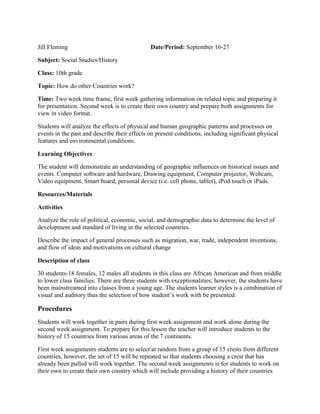
Lesson Plan Social Studies
- 1. Jill Fleming Date/Period: September 16-27 Subject: Social Studies/History Class: 10th grade Topic: How do other Countries work? Time: Two week time frame, first week gathering information on related topic and preparing it for presentation. Second week is to create their own country and prepare both assignments for view in video format. Students will analyze the effects of physical and human geographic patterns and processes on events in the past and describe their effects on present conditions, including significant physical features and environmental conditions. Learning Objectives The student will demonstrate an understanding of geographic influences on historical issues and events. Computer software and hardware, Drawing equipment, Computer projector, Webcam, Video equipment, Smart board, personal device (i.e. cell phone, tablet), iPod touch or iPads. Resources/Materials Activities Analyze the role of political, economic, social, and demographic data to determine the level of development and standard of living in the selected countries. Describe the impact of general processes such as migration, war, trade, independent inventions, and flow of ideas and motivations on cultural change Description of class 30 students-18 females, 12 males all students in this class are African American and from middle to lower class families. There are three students with exceptionalities; however, the students have been mainstreamed into classes from a young age. The students learner styles is a combination of visual and auditory thus the selection of how student’s work with be presented. Procedures Students will work together in pairs during first week assignment and work alone during the second week assignment. To prepare for this lesson the teacher will introduce students to the history of 15 countries from various areas of the 7 continents. First week assignments students are to select at random from a group of 15 crests from different countries, however, the set of 15 will be repeated so that students choosing a crest that has already been pulled will work together. The second week assignments is for students to work on their own to create their own country which will include providing a history of their countries
- 2. development, creating as much as possible a seal, crest, coat of arms and government structure that is different from what was studied in week one. Technology inclusion Student pair for first week assignment will use video and audio and incorporate these files into presentation software submit to instructor. Second week assignment student can use any and all technology devices and/or software to create their own country the minimum is to use at least two forms of technology iPod touch, iPads/Tablet, webcam from personal computer or Smartphone. This assignment is to be presented to the class by end of second week, of course as time permits. Each student will use a video via iPads, iPod touch or another video device to journal their account on the assignment. Upload the journal and submit to instructor by end of first week and the second week. Evaluation/Assessment Teacher-made tests and quizzes Teacher observation District-wide assessment Procedures Possible issues with software and hardware is that students may not have access at home to edit projects. In-school access to computers could be limited based on other classes needing use of the devices. If students do not have their own device they can use loaner equipment from school. Risk Analysis Possible conflict with partnership in completing first week assignment. Student lacking motivation or creativity when completing assignments. Loaner equipment issues such as repair and/or return.
